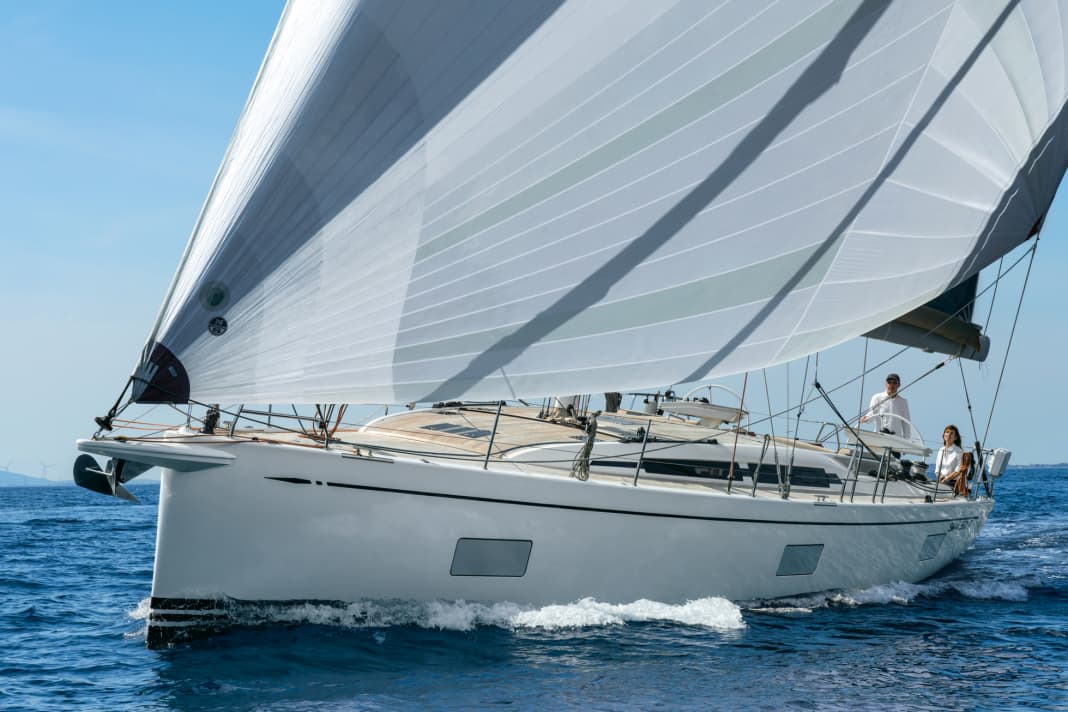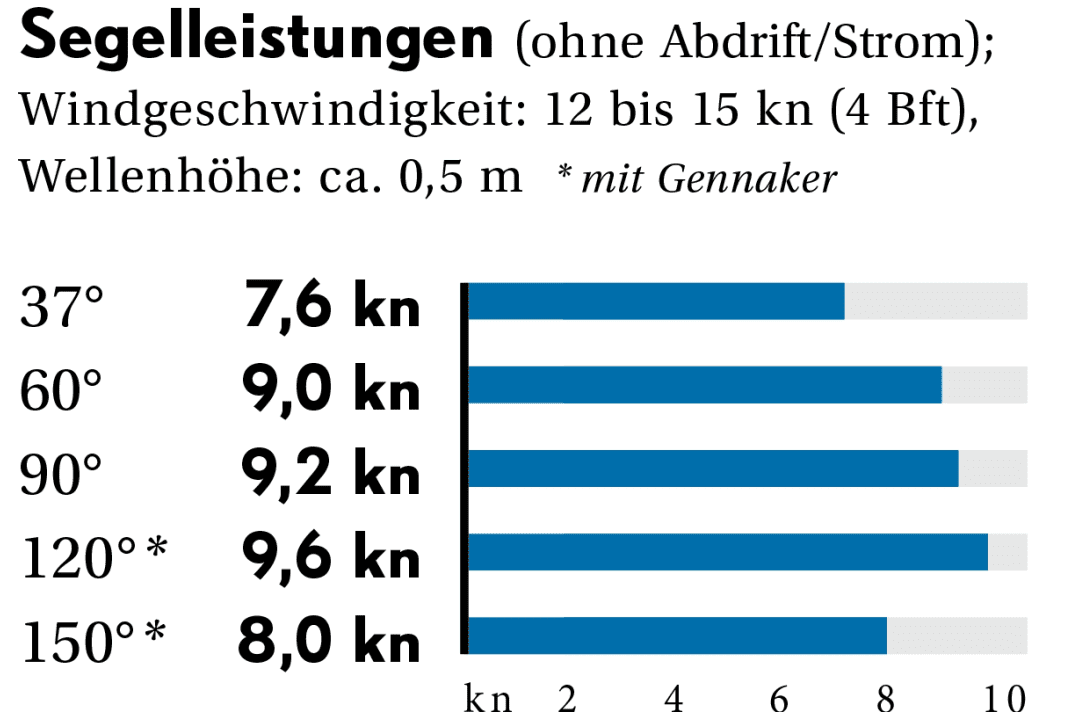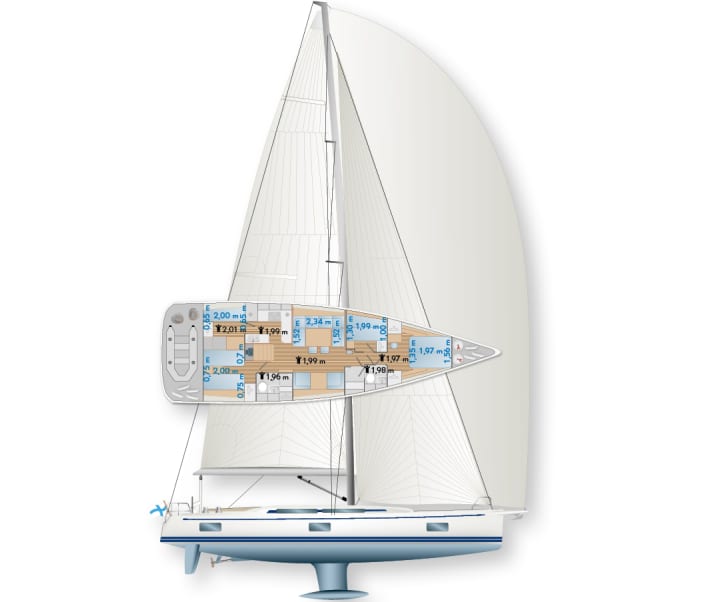





A visit on board is accompanied by many emotions. Joy at the sheer beauty, awe at the outstanding construction and finishing quality, respect for the excitingly complex and high-quality on-board technology and enthusiasm for the many small details that make the yacht what it is: a Swan.
The Italian-owned Finnish yacht builder Nautor has now launched the Swan 55, a modern successor to the highly successful 54. This means that the Swan range in the "lower" segment between 48 and 58 feet is once again bang up to date, with no fewer than four models, including the new Swan 51, which was recently announced at the trade fair in Cannes as a novelty for 2024.
The Swan 55 is unmistakably a Swan
The design for the new ship naturally comes once again from the office of Argentinean Germán Frers, who also designs for Hallberg-Rassy, among others. As for the Swedes, Frers works for the Finns from Nautor Swan with a very strong focus on line fidelity and brand homogeneity. A Swan is a Swan - unmistakable.
Double rudder blades are a Frers hobbyhorse. All eight models in the current Swan programme from 48 to 80 feet are now equipped with them. In addition, the modern, efficient T-keels with lead bulb have become standard within the range. In the case of the new 55, these are offered in three draught variants with 2.50 metres or alternatively with 2.10 or 3.40 metres, of course with corresponding adjustments to the ballast quantity. And Nautor also offers the boat with a hydraulic telescopic keel, also with a torpedo bomb. However, if you want the keel with variable draught, you will have to pay a mid-six-figure price. None of the 15 previous owners have realised this yet.
Over 2 million euros- without sail
The test boat is build number one, which cruises the Mediterranean under the name "Alegher", with the deep performance keel and a three-saling carbon fibre rig. Initially intended as standard, the aluminium mast is no longer specified for the basic equipment and is therefore no longer available.
From the shipyard, the Swan 55 will now be fitted with a carbon rig (mast and main boom) from French manufacturer Axxon Composites. The shipyard has also had to increase the basic price by more than 200,000 euros to achieve this. The price tag now stands at 2.05 million euros, still excluding VAT and sails, which is quite common for ships of this calibre.
Genoa or self-tacking jib- Both are possible on the Swan 55
The sail plan provides for the yacht to be operated either with an overlapping genoa and hoisting points on the side of the cabin superstructure or with a self-tacking jib. The fittings and rails are already fitted by the shipyard as standard for both variants. For long blue water passages, it is also possible to run an additional stay jib over the self-tacking rail while the larger genoa remains furled at the front.
Code Zero or Reacher can be attached to the bowsprit as a third headsail and remain furled, as is common on many modern ocean racing yachts today. All lines, halyards, sheets and trim lines are routed in channels below deck back into the cockpit to the side of the coamings. The layout leaves plenty of space between the stopper batteries and the two powerful sheet winches, which are arranged in a row one behind the other and spaced apart. This is an advantage for handling because all lines on each side can be operated from either winch.
The arrangement is at best disadvantageous for the helmsman, who can only reach the rear winch reasonably well from his position behind the wheel. This means that the crew must cooperate in the manoeuvres. The four large 70 mm winches (Harken Performa), which are all electrically operated as standard and can also be optionally activated by the helmsman at the push of a button directly on the steering columns, help with this.
The Swan 55 runs at enormous heights
Unfortunately, there is only a very short time window with reasonably favourable conditions available for the test run with the YACHT off Scarlino in Tuscany. With winds between 12 and 15 knots, the Swan 55 cruises at a speed of 7.6 knots. What is surprising is the good height that the boat can travel. The turning angles are only around 75 degrees, which fits into the performance range of real racing yachts. The windward speed (VMG), i.e. the theoretical speed that the boat can achieve against the wind, is calculated at over 6 knots. This is not only crucial for success on the race course, but is also advantageous for touring sailing.
Little feedback from the rudder
The helmsman has an easy job of it. The yacht, which weighs over 22 tonnes, reacts very directly and extremely lively to the rudder deflections and can therefore be steered optimally along the wind edge in a controlled manner. However, very little rudder pressure can be felt. Ambitious helmsmen may find the lack of feedback rather unpleasant, but this is normal for boats with double rudder blades.
The steering system, which is easily accessible through the aft peak, comes from Jefa and works via two separate chain hoists on the quadrants of the rudder shafts. These are in turn connected to each other with a trimmable push rod so that the angle of attack of the rudder blades can be easily adjusted. The elaborately installed, high-quality steering system is fully redundant. In addition, the autopilot directly accesses one of the quadrants, which provides additional safety in the event of a fault. An emergency tiller on board is therefore obsolete.
Unique bathing platform
The Swan 55's bathing platform is spectacular and unique on the market. The hatch not only opens the stern, but also the rear part of the aft deck. When extended and folded out using an elaborate mimic, a kind of lounge area unfolds, which can also be used as a sun lounger directly above the water with additional cushions.
The idea apparently came from shipyard owner Leonardo Ferragamo. However, the XXL bathing platform is only one option. The conventional stern platform with electro-hydraulic drives for folding out is standard. Thanks to the double rudder blades, an inflated inflatable dinghy measuring 2.5 metres in length, including motor, can be stowed transversely in the stern storage space.
The Swan 55 shines on the inside
The quality of Nautor Swan's interior fittings is legendary, and not just among industry experts. In addition to first-class craftsmanship in all areas, it is above all the countless small details that inspire. For example, the on-board installations (water supply, electrics, ventilation) are real treats for every technology fan and can redefine standards - even in the upper luxury class.
The fittings on the doors, storage compartments and in the wet rooms have also been selected to be better and of a higher quality than on many other ships. And the upholstery on the seats is ergonomically designed for optimum comfort with different foam thicknesses. These are just a few examples of the exceptionally exclusive nature of the interior fittings and the great effort that the shipyard has put into them. What's more, all berths are of course equipped with leeboards, the storage compartments are maximally well ventilated and, where possible, very easily accessible as drawers. In addition, softwood plugs are provided for safety in the event of water ingress.
Configure the interior fittings yourself
As is customary with Nautor Swan, the customer can configure the interior layout themselves within the range of options. For example, the aft living area on the port side can be converted into a skipper's cabin with its own toilet and separate access from the cockpit, a workshop or simply a walk-in storage space, depending on the owner's wishes.
Variance is also offered in the foredeck. Because the rig on the Swan 55 and therefore the main bulkhead are further aft in the boat, the shipyard is planning a second cabin for guests in addition to and behind the spacious master double cabin in the foredeck. This corresponds to the fit-out standard and is an exclusive feature within the length class.
This cabin can also be used in different ways, for example as an office or as a TV room, and it can be spatially and functionally linked to the owner's cabin if desired.
Nautor offers a total of over a hundred different customisation options for the Swan 55. So there are virtually no limits to individuality. Of course, good things don't come for free. The base price of just under 2.5 million euros gross for a ship with a hull length of 16.60 metres is a clear statement, or rather an acknowledgement by the shipyard of the fact that the new Swan 55 has hardly any comparable competition to fear in its market segment.



The Swan 55 in detail:

Technical data
- CE design category A
- Hull length 16.60 m
- Total length 17.75 m
- Waterline length 15.78 m
- Width 5.00 m
- Draught/altern. 2,50/2,10/3,40 m
- Draught telescopic keel 2.00-2.85 m
- Mast height above WL 23.22 m
- Theoretical hull speed 9.6 knots
- Weight 22.4 tonnes
- Ballast/proportion 7.5 t/33.5 %
- Mainsail 95,11 m²
- Self-tacking jib 80.11 m²
- Engine (Yanmar) 81 kW/110 hp
- Fuel tank 800 litres
- Fresh water tank 600 litres
Hull and deck construction
GRP sandwich with foam core and vinyl ester resin. Hull laminated with vacuum resin infusion, deck in hand lay-up. Main bulkhead made of GRP sandwich, watertight bulkheads fore and aft
Rig
Standard: Mast with three spreaders and main boom made of carbon fibre from Axxon Composites with rod shrouds. Boom kicker, outhaul and backstay adjustment with hydraulics
Motorisation
The 4JH110 four-cylinder engine from Yanmar is installed ex works, with shaft drive as standard. A saildrive can also be selected on request
Equipment and prices
- Base price ex shipyard € 2,439,500
- Price ready to sail € 2,525,390
- Comfort price € 2,544,670
As of 4/23, you can find out how the prices shown are defined here !
Guarantee/against osmosis
2/2 years
Shipyard
Oy Nautor AB, Nautor Swan; 68600 Pietarsaari (Finland); www.nautorswan.com
Distribution
Nautor Swan Germany, Hamburg; www.nautorswan.com
YACHT rating
The Swan 55 combines sheer luxury with strong sailing performance, outstanding build and finishing quality and a high degree of individuality. A yacht that is unrivalled
Design and concept
- + High-quality construction
- + Elegant hull lines
- + Innovative bathing platform
Sailing performance and trim
- + Very good height in the wind
- + Trimming at the touch of a button
- - Very little rudder pressure
Living and finishing quality
- + Very high quality standard
- + Practical expansion options
- + Lots of easy-to-use storage compartments
Equipment and technology
- + Perfectly installed on-board technology
- + Powerful machine as standard
- + High-quality control unit

